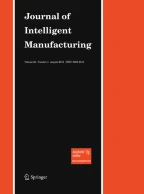Abstract
Nowadays, managing correctly the always changing customer demands is a challenge for companies, especially because of its impact on the Supply Chain (Forrester effect). Tactical planning is very useful in establishing robust plans. This paper proposes an alternative policy to traditional practices (frozen horizon . . .), the so-called “reference plan”, to obtain more stable and robust production plans at tactical level. Using an industrial application and simulations, we illustrate how the different practices contribute to robustness in planning. The “reference plan” policy seems to realize the best compromise between stability, robustness costs and service levels achieved by the tactical plans.
Similar content being viewed by others
References
Artigues C., Billaut J.C., Esswein C. (2005). Maximization of solution flexibility for robust shop scheduling. European Journal of Operational Research 165(2): 314–328
Bitran G.R., Hax A.C. (1977). On the design of hierarchical production planning systems. Decision Science 8, 28–55
Blackburn J.D., Kropp H.D., Millen R.A. (1986). Comparison of strategies to dampen nervousness in MRP systems. Management Science 32(4): 413–429
Carlson R.C., Beckman S.L., Kropp D.H. (1982). The effectiveness of extending the horizon in rolling production schedules. Decision Sciences 13(1): 129–146
Davenport, A. J., & Beck, J. C. (2000). A survey of techniques for scheduling with uncertainty. Available online at: www-poleia.lip6.fr/~sourd/gotha/index.html (accessed 01 January 2000)
De Kok A.G., Inderfurth K. (1997). Nervousness in inventory management: Comparison of basic control rules. European Journal of Operational Research 103, 55–82
Disney, S. M., & Towill, D. R. (2003). The effect of vendor managed inventory (VMI) dynamics on the Bullwhip Effect in Supply Chains. International Journal of Production Economics, 199–215.
Donselaar K.H.V., Nieuwenhof J.V.D., Visschers J. (2000). The impact of material coordination concepts on planning stability in supply chains. International Journal of Production Economics 68, 169–176
Durieux S., Pierreval H. (2003). Comparison of several design solutions of a real industrial manufacturing system using simulation and risk analysis. Industrial Engineering and Production Management conference 2, 145–154
Genin, P. (2003). Planification tactique robuste avec l’usage d’un APS ; proposition d’un mode de gestion par plan de référence, Ph-D thesis Ecole des Mines de Paris, Décembre 2003.
Heisig G. (1998). Planning stability under (s, S) inventory control rules. OR Spektrum 20(4): 215–228
Ho C. (1989). Evaluating the impact of operating environments on MRP system nervousness. International Journal of Production Research 27, 1115–1135
Jensen, T. (1993). Measuring and improving planning stability of reorder point lot-sizing policies. International Journal of Production Economics, 30–31, 167–178.
Kadipasaoglu S.N., Sridharan V. (1995). Alternative approaches for reducing schedule instability in multi-stage manufacturing under demand uncertainty. Journal of Operations Management 13, 193–211
Kimms A. (1998). Stability measures for rolling schedules with applications to capacity expansion planning, master production scheduling and lot sizing. International Journal of Management Science 26(3): 355–366
Kleijnen J.P.C., Gaury E. (2003). Short-term robustness of production management systems: A case study. European Journal of Operational Research 148, 452–465
Koltai T., Terlaky T. (2000). The difference between the managerial and mathematical interpretation of sensitivity analysis results in linear programming. International Journal of Production Economics 65, 257–274
Lee J.H., Yu Z.H. (1997). Worst-case formulations of model predictive control for systems with bounded parameters. Automatica 33, 765–781
Lim J.M., Kim K.S., Yum B.J., Hwang H. (1996). Determination of an optimal configuration of operating policies for direct-input-output manufacturing systems using the Taguchi method. Computers Industrial Engineering 31, 555–560
Ling, R. C. (2000). For true Enterprise integration, Turn First to SOP, APICS, The performance Advantage revue.
Miller, T. (2004). A hierarchical Supply Chain Planning Approach, Business Briefing. Global Purchasing & Supply Chain Strategies, 42–57.
Minifie J.R., Davis R.A. (1990). Interaction effects on MRP nervousness. International Journal of Production Research 28, 173–183
Mukhopadhyay, S. K., Dwived, Y. J., & Kumar, A. (1998). Design and implementation of an integrated Production Planning System for a pharmaceutical manufacturing concern in India. Production, Planning and Control, 9 n°4.
Orlicky J. (1975). Material Requirements Planning. McGraw-Hill, London
Rota, K., Thierry, C, & Bel, G. (2002). Supply Chain Management: A supplier perspective. Production Planning and Control, 370–380.
Roy B. (1998). A missing link in OR-DA: Robustness analysis. Foundations of Computing and Decision Sciences 23, 141–160
Simampo, A., Ryan, S.M. (2003). Capacity expansion for a loss system with exponential demand growth. Computers and operations research, 1525–1537.
Shang J.S., Li S., Tadikamalla P. (2004). Operational design of a supply chain system using the Taguchi method, response surface methodology, simulation, and optimization. International Journal of Production research 42(8): 3823–3849
Shobrys D.E., White D.C. (2000). Planning, scheduling and control systems: Why can they not work together. Computers and Chemical Engineering Journal 24, 163–173
Sridharan S.V., Laforge R.L. (1990). An analysis of alternative policies to achieve schedule stability. Journal of Manufacturing and Operations Management 3, 53–73
Stadtler H., Kilger C. ed. (2000). Supply Chain Management and Advanced Planning: Concepts Models, Software and Case Studies. Springer-Verlag, Berlin
Suhua H., Wu M.S. (2000). Demand and cost forecast error sensitivity analyses in aggregate production planning by possibilistic linear programming models. Journal of Intelligent Manufacturing 11(4): 355–364
Taguchi, G. (1987). Orthogonal arrays and linear graph, American Supplier Institute press.
Toly C. (2003). A fuzzy mid-term single-fab production planning model. Journal of Intelligent Manufacturing 14(3–4): 273–285
Vollmann T.E., Berry W.L., Whybark D.C. (1997). Manufacturing planning and control systems (4th ed). Irwin/McGraw Hill, New York
Yano C.A., Carlson R.C. (1987). Interaction between frequency of rescheduling and the role of safety stock in material requirements planning systems. International Journal of Production Research 25, 221–232
Zäpfel G. (1998). Customer-order-driven production: An economical concept for responding to demand uncertainty. International Journal of Production Economics 56/57, 699–709
Zhao X., Lee T.S. (1993). Freezing the master production schedule for material requirements planning systems under demand uncertainty. Journal of Operations Management 11(2): 185–205
Author information
Authors and Affiliations
Corresponding author
Rights and permissions
About this article
Cite this article
Genin, P., Thomas, A. & Lamouri, S. How to manage robust tactical planning with an APS (Advanced Planning Systems). J Intell Manuf 18, 209–221 (2007). https://doi.org/10.1007/s10845-007-0015-y
Received:
Accepted:
Published:
Issue Date:
DOI: https://doi.org/10.1007/s10845-007-0015-y
